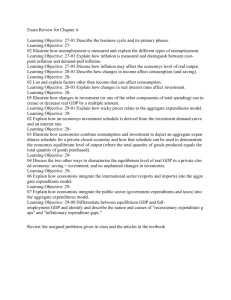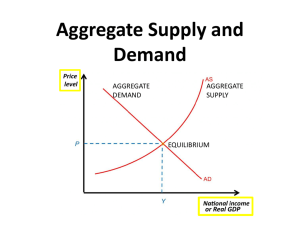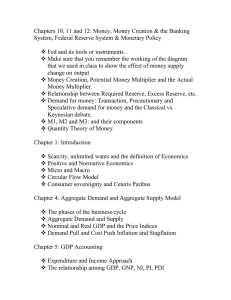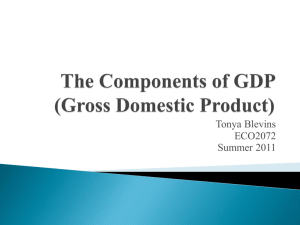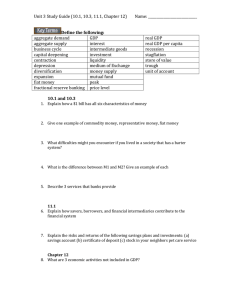Chapter 28 The Aggregate Expenditures Model CHAPTER OVERVIEW
advertisement
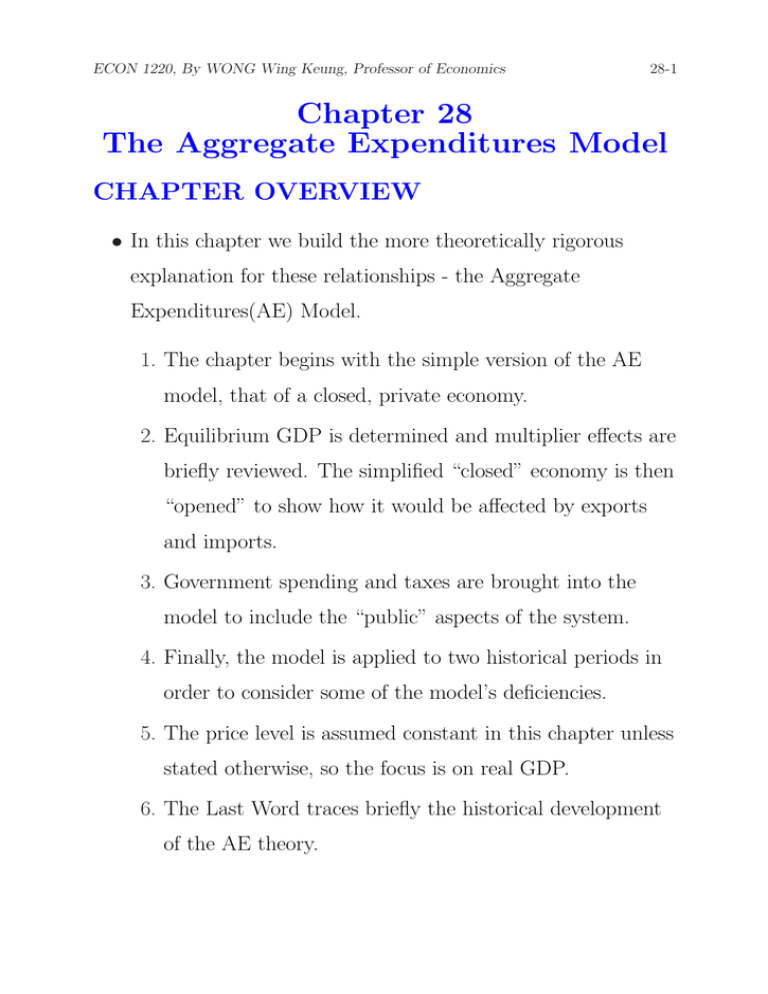
ECON 1220, By WONG Wing Keung, Professor of Economics 28-1 Chapter 28 The Aggregate Expenditures Model CHAPTER OVERVIEW • In this chapter we build the more theoretically rigorous explanation for these relationships - the Aggregate Expenditures(AE) Model. 1. The chapter begins with the simple version of the AE model, that of a closed, private economy. 2. Equilibrium GDP is determined and multiplier effects are briefly reviewed. The simplified “closed” economy is then “opened” to show how it would be affected by exports and imports. 3. Government spending and taxes are brought into the model to include the “public” aspects of the system. 4. Finally, the model is applied to two historical periods in order to consider some of the model’s deficiencies. 5. The price level is assumed constant in this chapter unless stated otherwise, so the focus is on real GDP. 6. The Last Word traces briefly the historical development of the AE theory. ECON 1220, By WONG Wing Keung, Professor of Economics 28-2 Objectives • Identify the simplifying assumptions of the Aggregate Expenditures (AE) model. • Explain the relationship between the investment demand curve and the investment schedule. • Use the consumption and investment schedules to determine the equilibrium level of GDP. • Explain verbally and graphically the equilibrium level of GDP. • Explain why above-equilibrium or below-equilibrium GDP levels will not persist. • Explain the basics of the classical view that the economy would generally provide full employment levels of output. • Trace the changes in GDP that will occur when there is a discrepancy between saving and planned investment. • Use the multiplier to find changes in GDP resulting from changes in spending. • Define the net export schedule. • Explain the impact of positive (or negative) net exports on aggregate expenditures and the equilibrium level of real GDP. • Explain the effect of increases (or decreases) in exports on real GDP. • Explain the effect of increases (or decreases) in imports on real GDP. ECON 1220, By WONG Wing Keung, Professor of Economics 28-3 • Describe how government purchases affect equilibrium GDP. • Describe how personal taxes affect equilibrium GDP. • Explain why an equal amount of government purchases and taxes will have a differential impact on GDP. • Identify a recessionary expenditure gap and explain how it relates to the U.S. recession of 2001. • Explain how the U.S. managed full-employment output in 2005 while experiencing large negative net exports. • Identify an inflationary gap and explain how it relates to the inflationary experience of the lat 1980s. • List five limitations of the aggregate expenditures model. • Explain how the aggregate expenditures model emerged as a critique of Classical economics and in response to the Great Depression. • Define and identify terms and concepts listed at the end of the chapter. ECON 1220, By WONG Wing Keung, Professor of Economics 28-4 The Aggregate Expenditures Model • What determinates the level of GDP, given a nation’s production capacity? • What causes real GDP to rise in one period and to fall in another? • To answer these questions, John Maynard Keynes develops in 1936. • Also known as the “Keynesian cross” model. ECON 1220, By WONG Wing Keung, Professor of Economics 28-5 Introduction-What Determines GDP? • Learning objectives – How economists combine consumption and investment to depict an aggregate expenditures schedule for a private closed economy. – The three characteristics of the equilibrium level of real GDP in a private closed economy: ∗ aggregate expenditures = output; ∗ saving = investment; and ∗ no unplanned changes in inventories. How changes in equilibrium real GDP can occur and how those changes relate to the multiplier. – How economists integrate the public sector (government expenditures and taxes) and the international sector (exports and imports) into the aggregate expenditures model. – About the nature and causes of “recessionary expenditure gaps” and “inflationary expenditure gaps.” • This chapter focuses on the aggregate expenditures model. We use the definitions and facts from previous chapters to shift our study to the analysis of economic performance. The aggregate expenditures model is one tool in this analysis. Recall that “aggregate” means total. ECON 1220, By WONG Wing Keung, Professor of Economics 28-6 • As explained in this chapter’s Last Word, the model originated with John Maynard Keynes. • The focus is on the relationship between income and consumption and savings. • Investment spending, net exports, and government purchases, important parts of aggregate expenditures, are also examined. • Finally, these spending categories are combined to explain the equilibrium levels output and employment in at first a private (no government), domestic (no foreign sector) economy. Therefore, GDP = N I = P I = DI in this very simple model. • The revised model adds realism by including the foreign sector and government in the aggregate expenditures model. H. Applications of the new model include two U.S. historical periods (the 2001 recession and the 2005 period of full employment with large negative net exports). ECON 1220, By WONG Wing Keung, Professor of Economics 28-7 Model Simplifications • Note: – As Keynes created the Aggregate Expenditures(AE) Model during the middle of the Great Depression, the assumptions underpinning the model reflect the economic conditions that were prevalent during the Great Depression. • Assumptions: 1. Private closed economy – We first assume a “closed economy” with no international trade. 2. Consumption and investment only – Government is ignored. 3. Prices are fixed – The AE model is an extreme version of a sticky price model. – It is a stuck-price model since prices cannot change at all. – Since it reflects the Great Depression situation, even if a sudden increase in demand occurred, prices were unlikely to rise because of the massive oversupply of productive resources. 4. Excess capacity exists – The equilibrium level of GDP is well below a nation’s potential output. ECON 1220, By WONG Wing Keung, Professor of Economics 28-8 5. Unemployed labor exists 6. Disposable income = real GDP – No taxes 7. Although both households and businesses save, we assume here that all saving is personal. 8. Depreciation and net foreign income are assumed to be zero for simplicity. • There are two reminders concerning these assumptions: 1. They leave out two key components of aggregate demand (government spending and foreign trade), because they are largely affected by influences outside the domestic market system. 2. With no government or foreign trade, GDP, national income (NI), personal income (PI), and disposable income (DI) are all the same. ECON 1220, By WONG Wing Keung, Professor of Economics 28-9 Consumption and Investment Schedules • The theory assumes that the level of output and employment depend directly on the level of aggregate expenditures. Changes in output reflect changes in aggregate spending. • In a closed private economy the two components of aggregate expenditures are consumption C and gross investment Ig . • The consumption schedule was developed in Chapter 27 – see Figure 27.2a. • In addition to the investment demand schedule, economists also define an investment schedule that shows the amounts business firms collectively intend to invest (planned investment) at each possible level of GDP. – In developing the investment schedule, it is assumed that investment is independent of the current income. – The line Ig (gross investment) in Figure 28.1b and PPT 28-4 shows this graphically related to the level determined by Figure 28.1a. ∗ The figures show the real interest rate is 8% and the firms will spend $20 billion of investment. ECON 1220, By WONG Wing Keung, Professor of Economics 28-10 – The assumption that investment is independent of income is a simplification, but will be used here. ∗ This assumption tells us that this $20 billion of investment will occur at both low and high levels of GDP. – Figure 28.1a shows the investment schedule from GDP levels given in Table 27.1. • Combine the consumption schedule with investment schedule, we have C + Ig = GDP at equilibrium. ECON 1220, By WONG Wing Keung, Professor of Economics 28-11 Equilibrium GDP: Expenditures-Output Approach • Look at Table 28.2 or PPT 28-6, which combines data of Tables 27.1 and 28.1. • Real domestic output in column 2 shows ten possible levels that producers are willing to offer, assuming their sales would meet the output planned. – e.g., they will produce $370 billion of output if they expect to receive $370 billion in revenue. • Ten levels of aggregate expenditures are shown in column 6. The column shows the amount of consumption and planned gross investment spending (C + Ig ) forthcoming at each output level (in a closed economy). – Recall that consumption level is directly related to the level of income and that here income is equal to output level. – Investment is independent of income here and is planned or intended regardless of the current income situation. • The planned investment in column 5 shows the amounts business firms plan or intend to invest, not the amounts they actually will invest. ECON 1220, By WONG Wing Keung, Professor of Economics 28-12 Equilibrium GDP • Equilibrium GDP is the level of output whose production will create total spending just sufficient to purchase that output (C + Ig = GDP ). Otherwise there will be a disequilibrium situation (C + Ig 6= GDP ). – In Table 28.2, this occurs only at $470 billion. – At $410 billion GDP level, total expenditures (C + Ig ) would be $425 = $405(C) + $20 (Ig ) and businesses will adjust to this excess demand (revealed by the declining inventories) by stepping up production. They will expand production at any level of GDP less than the $470 billion equilibrium. – At levels of GDP above $470 billion, such as $510 billion, aggregate expenditures will be less than GDP. At $510 billion level, C + Ig = $500 billion. Businesses will have unsold, unplanned inventory investment and will cut back on the rate of production. As GDP declines, the number of jobs and total income will also decline, but eventually the GDP and aggregate spending will be in equilibrium at $470 billion. ECON 1220, By WONG Wing Keung, Professor of Economics 28-13 Graphical Analysis • Graphical analysis is shown in Figure 28.2 and PPT 28-7. • In the 45-degree line, output = aggregate expenditures, or the equilibrium position. – The value of what is being measured on the horizontal axis (GDP) is equal to the value of what is measured on the vertical axis (aggregate expenditures, C + Ig ). • To graph the aggregate expenditures schedule onto figure 28.2, – we duplicate the consumption schedule C in figure 27.2a and add to it vertically the constant $20 billion amount of investment Ig to become C + Ig – Observe that the aggregate expenditures line rises with output and income, but not as much as income, due to the marginal propensity to consume (the slope) being less than 1. – A part of every increase in disposable income will not be spent but will be saved. – The data show that the aggregate expenditures rise by $15 billion for every $20 billion increase in real output and income because $5 billion of each $20 billion increment is saved. – Thus, the slope of the aggregate expenditures is .75 = $15/$20. ECON 1220, By WONG Wing Keung, Professor of Economics 28-14 • At $470 billion it shows the C + Ig schedule intersecting the 45-degree line which is where output = aggregate expenditures, or the equilibrium position. • At equilibrium – Saving and planned investment are equal (S = Ig ). – There are no unplanned changes in inventories. ECON 1220, By WONG Wing Keung, Professor of Economics 28-15 Two Other Features of Equilibrium GDP • Savings and planned investment are equal (S = Ig ). – It is important to note that in our analysis above we spoke of “planned” investment. At GDP = $470 billion in Table 28.2, both saving and planned investment are $20 billion. – Saving represents a “leakage” from spending stream and causes C to be less than GDP. – Because of saving, consumption by itself is insufficient to remove domestic output, apparently setting the stage for a decline in total output. – Some of output is planned for business investment and not consumption, so this investment spending can replace the leakage due to saving. – If aggregate spending is less than equilibrium GDP, e.g., it is in Table 28.2, line 8 when GDP is $510 billion, ∗ Households will save $30 billion but firms will plan to invest only $20 billion. ∗ This $10 billion excess of saving over planned investment will reduce total spending to $10 billion below the value of total output. ∗ This spending deficiency will reduce real GDP. ECON 1220, By WONG Wing Keung, Professor of Economics 28-16 ∗ then businesses will find themselves with unplanned inventory investment on top of what was already planned. This unplanned portion is reflected as a business expenditure, even though the business may not have desired it, because the total output has a value that belongs to someone-either as a planned purchase or as an unplanned inventory. – If aggregate expenditures exceed GDP, ∗ then there will be less inventory investment than businesses planned as businesses sell more than they expected. ∗ This is reflected as a negative amount of unplanned investment in inventory. ∗ For example, at $450 billion GDP, there will be $435 billion of consumer spending, $20 billion of planned investment, so businesses must have experienced a $5 billion unplanned decline in inventory because sales exceed that expected. • In equilibrium there are no unplanned changes in inventory. – unplanned changes in inventory play a major role in achieving equilibrium GDP. E.g., – consider row 7 of Table 28.2 where GDP is $490 billion – above-equilibrium GDP, ∗ here C + Ig is only $485 billion and will be less than output by $5 billion. ECON 1220, By WONG Wing Keung, Professor of Economics 28-17 ∗ Firms retain the extra $5 billion as unplanned inventory investment. ∗ Actual investment is $25 billion, or $5 billion more than the $20 billion planned. ∗ So $490 billion is an above-equilibrium output level. ∗ The $5 billion unplanned changes in inventory will prompt them to cut back employment and production. ∗ GDP will fall to its equilibrium level of $470 billion in which the unplanned changes in inventory are zero. – Consider row 5, Table 28.2. Here $450 billion is a below-equilibrium output level because actual investment will be $5 billion less than planned. ∗ Similarly, inventories decline below what was planned, resulting from the excess of sales over production, will encourage firms to expand production. ∗ GDP will rise to $470 billion. • Quick Review: Equilibrium GDP is where aggregate expenditures equal real domestic output. – C + planned Ig = GDP and S = Ig . – A difference between saving and planned investment causes a difference between the production and spending plans of the economy as a whole. – This difference between production and spending plans leads to ECON 1220, By WONG Wing Keung, Professor of Economics 28-18 unintended inventory investment or unintended decline in inventories. – As long as unplanned changes in inventories occur, businesses will revise their production plans upward or downward until the investment in inventory is equal to what they planned. This will occur at the point that household saving is equal to planned investment. – Only where planned investment and saving are equal will there be no unintended investment or disinvestment in inventories to drive the GDP down or up. ECON 1220, By WONG Wing Keung, Professor of Economics 28-19 Changes in Equilibrium GDP and the Multiplier • an initial change in spending will be acted on by the multiplier to produce larger changes in output. – The equilibrium GDP will change in response to changes in either the investment schedule or the consumption schedule. – changes in the investment schedule are the main source of instability. – The “initial change” represented in the text and Figure 28.3 is in planned investment spending. It could also result from a nonincome-induced change in consumption. • Figure 28.3 shows the impact of changes in investment. • Suppose investment spending increases by $5 billion. – due to a rise in profit expectations or to a decline in interest rates. – Figure 28.3 shows the increase in aggregate expenditures will shift (C + Ig )0 upward to (C + Ig )1 and raise equilibrium real GDP frm $470 billion to $490 billion. – In this case, the $5 billion increase in investment leads to a $20 billion increase in equilibrium GDP. – The multiplier in Figure 28.3 is 4 (=$20/$5 =1/MPS). ECON 1220, By WONG Wing Keung, Professor of Economics 28-20 – The MPS is .25 meaning that for every $1 billion of new income, $.25 billion of new saving occurs. – Thus, $20 billion of new income is needed to generate $5 billion of new saving. • Conversely, a decline in investment spending of $5 billion is shown to create a decrease in equilibrium GDP of $20 billion to $450 billion. ECON 1220, By WONG Wing Keung, Professor of Economics 28-21 International Trade and Equilibrium Output • We move from a closed economy to an open economy that incorporate exports (X) and imports (M ). – Net exports (exports minus imports, Xn ) affect aggregate expenditures in an open economy. Exports expand and imports contract aggregate spending on domestic output. – Exports (X) create domestic production, income, and employment due to foreign spending on U.S. produced goods and services. – Imports (M ) reduce the sum of consumption and investment expenditures by the amount expended on imported goods, so this figure must be subtracted so as not to overstate aggregate expenditures on U.S. produced goods and services. – The aggregate expenditures for a private open economy are then C + Ig + Xn where Xn = X − M is net exports. • The net export schedule (Table 28.3): – Shows hypothetical amount of net exports (X - M) that will occur at each level of GDP given in Table 28.2. ECON 1220, By WONG Wing Keung, Professor of Economics 28-22 – Assumes that net exports are autonomous or independent of the current GDP level. – Figure 28.4b shows Table 28.3 graphically. ∗ Xn1 shows a positive $5 billion in net exports. ∗ Xn2 shows a negative $5 billion in net exports. • The impact of net exports on equilibrium GDP is illustrated in Figure 28.4a: • Positive net exports increase aggregate expenditures beyond what they would be in a closed economy and thus have an expansionary effect. – The aggregate expenditures for the open economy become C + Ig + Xn1 – The multiplier effect also is at work. In Figure 28.4a we see that positive net exports of $5 billion lead to a positive change in equilibrium GDP of $20 billion (to $490 from $470 billion), implying a multiplier of 4. This comes from Table 28.2 and Figure 28.3. • Negative net exports decrease aggregate expenditures beyond what they would be in a closed economy and thus have a contractionary effect. ECON 1220, By WONG Wing Keung, Professor of Economics 28-23 – The aggregate expenditures for the open economy become C + Ig + Xn2 – The multiplier effect also is at work here. In Figure 28.4a we see that negative net exports of $5 billion lead to a negative change in equilibrium GDP of $20 billion (to $450 from $470 billion). • Global Perspective 28.1 and PPT 28-12 show 2006 net exports for various nations. • International economic linkages: – Prosperity abroad generally raises our exports and transfers some of their prosperity to us. (Conversely, recession abroad has the reverse effect.) – Tariffs on U.S. products may reduce our exports and depress our economy, causing us to retaliate and worsen the situation. Trade barriers in the 1930s contributed to the Great Depression. – Exchange rates: Depreciation of the dollar lowers the cost of American goods to foreigners and encourages exports from the U.S. while discouraging the purchase of imports in the U.S. This could lead to higher real GDP or to inflation, depending on the domestic employment situation. Appreciation of the dollar could have the opposite impact. ECON 1220, By WONG Wing Keung, Professor of Economics 28-24 Adding the Public Sector • We move the analysis from a private (no-government) open economy to an economy with a public sector (sometimes called a “mixed economy”) – to add government purchases and taxes to the model. • Simplifying assumptions are helpful for clarity when we include the government sector in our analysis. – Simplified investment and net export schedules are used. We assume they are independent of the level of current GDP. – We assume government purchases do not impact private spending schedules. – We assume that net tax revenues are derived entirely from personal taxes so that GDP, NI, and PI remain equal. DI is PI minus net personal taxes. – A fixed amount of taxes is collected regardless (independent) of GDP level (a lump-sum tax) – The price level is assumed to be constant unless otherwise indicated. ECON 1220, By WONG Wing Keung, Professor of Economics 28-25 Government Purchases and Equilibrium GDP • The aggregate expenditures for a open economy with a public sector become C + Ig + Xn + G • Suppose the government decides to purchase $20 billion of goods and services regardless of the level of GDP and tax collections. – Table 28.4 gives a tabular example of including $20 billion in government spending and Figure 28.5 gives the graphical illustration. – Increases in government spending boost the equilibrium GDP from $470 billion to $550 billion. – Increases in government spending shift the aggregate expenditures upward and produce a higher level of GDP – Government spending is subject to the multiplier. – An $20 billion increases in government purchases has increased the equilibrium GDP by $80 billion, with multiplier to be 4 = $80/$20. ECON 1220, By WONG Wing Keung, Professor of Economics 28-26 Taxation and Equilibrium GDP • Suppose a fixed amount of a lump-sum tax, say $20 billion, is collected regardless of GDP level • Table 28.5 and Figure 28.6 show the impact of a tax increase. – Taxes reduce disposable (after-tax) income (DI) and, therefore, lower both consumption and saving at each level of GDP. – Since MPC =.75 and MPS = .25, government tax of $20 billion will reduce consumption by $15 billion (= .75 × $20 billion) and reduce saving by $5 billion (= .25 × $20 billion) – Thus, the after-tax consumption Ca is $15 billion less at each level of GDP. – An increase in taxes will lower the aggregate expenditures schedule relative to the 45-degree line and reduce the equilibrium GDP. – The aggregate expenditures become $490 billion Ca + Ig + Xn + G – The $20 billion lump-sum tax has reduced equilibrium GDP by $60 billion, from $550 billion to $490 billion – With no change in government expenditures, tax increases lower the aggregate expenditures schedule and reduce the equilibrium GDP. ECON 1220, By WONG Wing Keung, Professor of Economics • 28-27 Government purchases and taxes have different impacts. – In our example, equal additions in government spending and taxation increase the equilibrium GDP. ∗ If G and T are each increased by a particular amount, the equilibrium level of real output will rise by that same amount. ∗ In the text’s example, an increase of $20 billion in G and an offsetting increase of $20 billion in T will increase equilibrium GDP by $20 billion (from $470 billion to $490 billion). – The example reveals the rationale. ∗ An increase in G is direct and adds $20 billion to aggregate expenditures. ∗ An increase in T has an indirect effect on aggregate expenditures because T reduces disposable incomes first, and then C falls by the amount of the tax times MPC. ∗ The overall result is a rise in initial spending of $20 billion minus a fall in initial spending of $15 billion (.75 × $20 billion), which is a net upward shift in aggregate expenditures of $5 billion. When this is subject to the multiplier effect, which is 4 in this example, the increase in GDP will be equal to 4 × $5 billion or $20 billion, which is the size of the change in G. ECON 1220, By WONG Wing Keung, Professor of Economics 28-28 Equilibrium revisited • As demonstrated earlier, in a closed private economy equilibrium occurs when saving (a leakage) equals planned investment (an injection) : S = Ig . • With the introduction of a foreign sector (net exports) and a public sector (government), new leakages and injections are introduced. – Imports and taxes are added leakages. – Exports and government purchases are added injections. • Equilibrium is found when the leakages equal the injections. – When leakages equal injections, there are no unplanned changes in inventories. – Symbolically, equilibrium occurs when Sa + M + T = Ig + X + G, where Sa is after-tax saving, M is imports, T is taxes, Ig is (gross) planned investment, X is exports, and G is government purchases. – Table 28.5 confirms that, at equilibrium GDP, the sum of leakages equals the sum of injections. Saving + Imports + Taxes = Investment+ Exports + Government Purchases. ECON 1220, By WONG Wing Keung, Professor of Economics 28-29 Equilibrium vs. Full-Employment GDP • A recessionary expenditure gap exists when equilibrium GDP is below full-employment GDP. – See Key Graph 28.7a or PPT 28-17. – Recessionary expenditure gap of $5 billion is the amount by which aggregate expenditures fall short of those required to achieve the full-employment level of GDP. – In Table 28.5, assuming the full-employment GDP is $510 billion, the corresponding level of total expenditures there is only $505 billion. The gap would be $5 billion, the amount by which the schedule would have to shift upward to realize the full-employment GDP. – Graphically, the recessionary expenditure gap is the vertical distance by which the aggregate expenditures schedule (Ca + Ig + Xn + G)1 lies below the full-employment point on the 45-degree line. – Because the multiplier is 4, we observe a $20-billion differential (the recessionary gap of $5 billion times the multiplier of 4) between the equilibrium GDP and the full-employment GDP. – Keynes’ Solution: ∗ Government purchases and/or tax reduction. ECON 1220, By WONG Wing Keung, Professor of Economics 28-30 • An inflationary expenditure gap exists when aggregate expenditures exceed full-employment GDP. – Figure 28.7b and PPT 28-18 show that a demand-pull inflationary expenditure gap of $5 billion exists when aggregate spending exceeds what is necessary to achieve full employment. – The inflationary expenditure gap is the amount by which the aggregate expenditures schedule must shift downward to realize the full-employment noninflationary GDP. – The effect of the inflationary expenditure gap is to pull up the prices of the economy’s output. – In this model, if output can’t expand, pure demand-pull inflation will occur. ECON 1220, By WONG Wing Keung, Professor of Economics 28-31 Historical Applications • The U.S. recession of 2001 provides a good illustration of a recessionary expenditure gap. – U.S. overcapacity and business insolvency resulted from excessive expansion by businesses in the 1990s, a period of prosperity. – Internet-related companies proliferated during the 1990s, despite their lack of profitability, but fueled by speculative interest in the stocks of these start-up firms. – Consumer debt grew as people borrowed against their expectations of rising wealth in financial markets. – Fraud by executives and accountants led to speculative excesses and set up firms to fail. – Beginning in 2000, a dramatic drop in stock market values occurred, causing pessimism and highly unfavorable conditions for acquiring additional investment funds. – In March 2001 aggregate expenditures declined and the economy fell into its 9th recession since 1950. – The terrorist attacks on September 11, 2001, further undermined consumer confidence and contributed to the downturn. 8. Unemployment has since declined, but for a long period it remained high, leading some to refer to the upturn as a “jobless recovery,” where output rises, but labor market conditions remain weak. ECON 1220, By WONG Wing Keung, Professor of Economics 28-32 In 2007 the U.S. experienced both full employment (no recessionary or inflationary expenditure gap) and large negative net exports. – These two events seemingly contradict, as theory would predict that negative net exports would lead to recessionary conditions. – Domestic consumption (negative saving), investment, and government purchases maintained full employment conditions despite the negative net exports. – Domestic spending was supported by foreign lending, allowing the full employment conditions to occur. ECON 1220, By WONG Wing Keung, Professor of Economics 28-33 Say’s Law, The Great Depression, and Keynes • Until the Great Depression of the 1930, most economists going back to Adam Smith had believed that a market system would ensure full employment of the economy’s resources except for temporary, short-term upheavals. • If there were deviations, they would be self-correcting. A slump in output and employment would reduce prices, which would increase consumer spending; would lower wages, which would increase employment again; and would lower interest rates, which would expand investment spending. • Say’s law, attributed to the French economist J. B. Say in the early 1800s, summarized the view in a few words: “Supply creates its own demand.” • Say’s law is easiest to understand in terms of barter. The woodworker produces furniture in order to trade for other needed products and services. All the products would be traded for something, or else there would be no need to make them. Thus, supply creates its own demand. • Reformulated versions of these classical views are still prevalent among some modern economists today. ECON 1220, By WONG Wing Keung, Professor of Economics 28-34 • The Great Depression of the 1930s was worldwide. GDP fell by 40 percent in U.S. and the unemployment rate rose to nearly 25 percent (when most families had only one breadwinner). The Depression seemed to refute the classical idea that markets were self-correcting and would provide full employment. • John Maynard Keynes in 1936 in his General Theory of Employment, Interest, and Money, provided an alternative to classical theory, which helped explain periods of recession. – Not all income is always spent, contrary to Say’s law. – Producers may respond to unsold inventories by reducing output rather than cutting prices. – A recession or depression could follow this decline in employment and incomes. • The modern aggregate expenditures model is based on Keynesian economics or the ideas that have arisen from Keynes and his followers since. It is based on the idea that saving and investment decisions may not be coordinated, and prices and wages are not very flexible downward. Internal market forces can therefore cause depressions and government should play an active role in stabilizing the economy.
